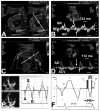Finding the "PR-fect" solution: what is the best tool to measure fetal cardiac PR intervals for the detection and possible treatment of early conduction disease?
- PMID: 22494551
- PMCID: PMC3396786
- DOI: 10.1111/j.1747-0803.2012.00652.x
Finding the "PR-fect" solution: what is the best tool to measure fetal cardiac PR intervals for the detection and possible treatment of early conduction disease?
Abstract
In the absence of structural heart disease, the great majority of cases with complete congenital heart block will be associated with the maternal autoantibodies directed to components of the SSA/Ro-SSB/La ribonucleoprotein complex. Usually presenting in fetal life before 26 weeks' gestation, once third-degree (complete) heart block develops, it is irreversible. Therefore, investigators over the past several years have attempted to predict which fetuses will be at risk for advanced conduction abnormalities by identifying a biomarker for less severe or incomplete disease, in this case, PR interval prolongation or first-degree atrioventricular block. In this state-of-the-art review, we critically analyze the various approaches to defining PR interval prolongation in the fetus, and then analyze several clinical trials that have attempted to address the question of whether complete heart block can be predicted and/or prevented. We find that, first and foremost, definitions of first-degree atrioventricular block vary but that the techniques themselves are all similarly valid and reliable. Nevertheless, the task of predicting those fetuses at risk, and who are therefore candidates for treatment, remains challenging. Of concern, despite anecdotal evidence, there is currently no conclusive proof that a prolonged PR interval predicts complete heart block.
© 2012 Wiley Periodicals, Inc.
Conflict of interest statement
Conflict of Interest: None declared.
Dr. Friedman is on the Speakers Bureau of and is a consultant for, MedImmune.
Figures


Similar articles
-
Prevention of complete heart block in children of mothers with anti-SSA/Ro and anti-SSB/La autoantibodies: detection and treatment of first-degree atrioventricular block.Curr Opin Rheumatol. 2009 Sep;21(5):478-82. doi: 10.1097/BOR.0b013e32832ed817. Curr Opin Rheumatol. 2009. PMID: 19584727 Review.
-
Utility of cardiac monitoring in fetuses at risk for congenital heart block: the PR Interval and Dexamethasone Evaluation (PRIDE) prospective study.Circulation. 2008 Jan 29;117(4):485-93. doi: 10.1161/CIRCULATIONAHA.107.707661. Epub 2008 Jan 14. Circulation. 2008. PMID: 18195175
-
Early diagnosis and treatment of atrioventricular block in the fetus exposed to maternal anti-SSA/Ro-SSB/La antibodies: a prospective, observational, fetal kinetocardiogram-based study.Circulation. 2009 Apr 14;119(14):1867-72. doi: 10.1161/CIRCULATIONAHA.108.773143. Epub 2009 Mar 30. Circulation. 2009. PMID: 19332471
-
Congenital heart block in neonatal lupus: the pediatric cardiologist's perspective.Indian J Pediatr. 2002 Jun;69(6):517-22. doi: 10.1007/BF02722656. Indian J Pediatr. 2002. PMID: 12139139 Review.
-
Atrioventricular conduction delay in fetuses exposed to anti-SSA/Ro and anti-SSB/La antibodies: a magnetocardiography study.Clin Dev Immunol. 2012;2012:432176. doi: 10.1155/2012/432176. Epub 2012 Dec 20. Clin Dev Immunol. 2012. PMID: 23320018 Free PMC article.
Cited by
-
Pregnancy and Autoimmune Disease.Dtsch Arztebl Int. 2022 Mar 4;119(9):145-156. doi: 10.3238/arztebl.m2021.0353. Dtsch Arztebl Int. 2022. PMID: 34874264 Free PMC article. Review.
-
Fetal cardiac arrhythmias: Current evidence.Ann Pediatr Cardiol. 2018 May-Aug;11(2):148-163. doi: 10.4103/apc.APC_134_17. Ann Pediatr Cardiol. 2018. PMID: 29922012 Free PMC article. Review.
-
Autoimmune-associated Congenital Heart Block: A New Insight in Fetal Life.Chin Med J (Engl). 2017 Dec 5;130(23):2863-2871. doi: 10.4103/0366-6999.219160. Chin Med J (Engl). 2017. PMID: 29176145 Free PMC article. Review.
-
Prenatal Detection of Wolff-Parkinson-White Syndrome Using the Atrioventricular Interval on Fetal Echocardiogram.CJC Pediatr Congenit Heart Dis. 2024 Sep 20;4(1):1-6. doi: 10.1016/j.cjcpc.2024.09.003. eCollection 2025 Feb. CJC Pediatr Congenit Heart Dis. 2024. PMID: 40170989 Free PMC article.
-
Case Report: Prenatal Diagnosis and Treatment of Fetal Autoimmune-Associated First-Degree Atrioventricular Block: First Report From China.Front Cardiovasc Med. 2021 Jun 21;8:683486. doi: 10.3389/fcvm.2021.683486. eCollection 2021. Front Cardiovasc Med. 2021. PMID: 34235189 Free PMC article.
References
-
- Jaeggi ET, Silverman ED, Yoo S-J, Kingdom J. Is immune-mediated complete fetal atrioventricular block reversible by transplacental dexamethasone therapy? Ultrasound Obstet Gynecol. 2004;23:602–605. - PubMed
-
- Gordon PA. Congenital heart block: clinical features and therapeutic approaches. Lupus. 2007;16:642–646. - PubMed
-
- Bruer JMPJ, Kapusta L, Stoutenbeek P, Visser GHA, Van den Berg P, Meijboom EJ. Isolated congenital complete atrioventricular block diagnosed in utero: Natural history and outcome. J Mat Fetal Neonat Med. 2008;21:469–476. - PubMed
-
- Mevorach D, Elchalal U, Rein AJJT. Prevention of complete heart block in children of mothers with anti-SSA/Ro and anti-SSB/La autoantibodies: detection and treatment of first-degree atrioventricular block. Curr Opin Rheumatol. 2009;21:478–482. - PubMed
Publication types
MeSH terms
Supplementary concepts
Grants and funding
LinkOut - more resources
Full Text Sources
Research Materials
Miscellaneous

